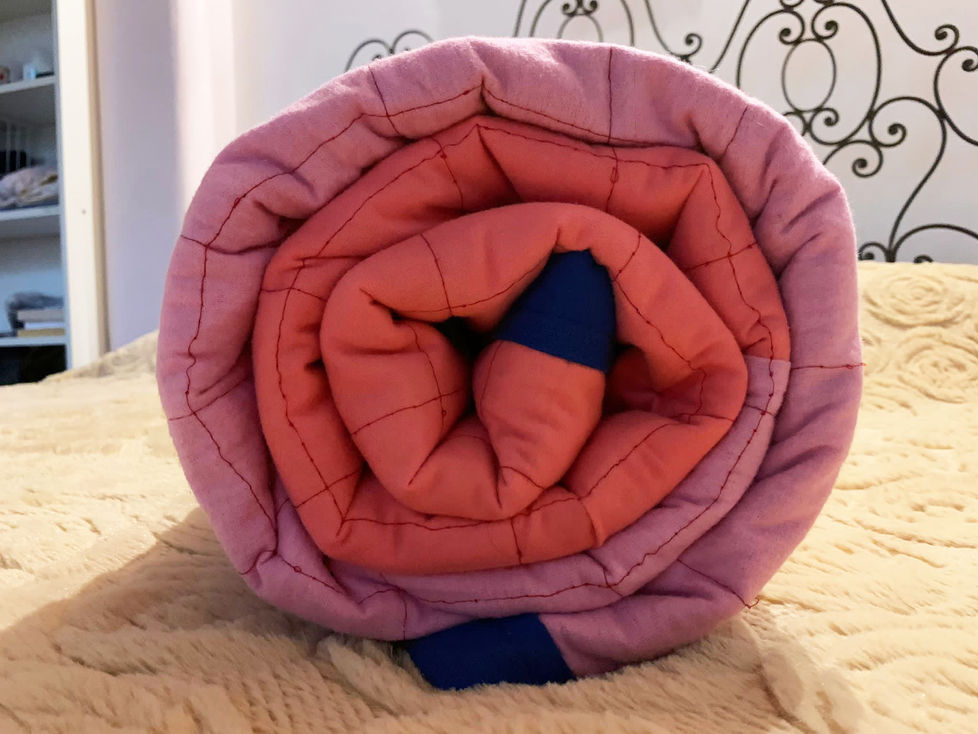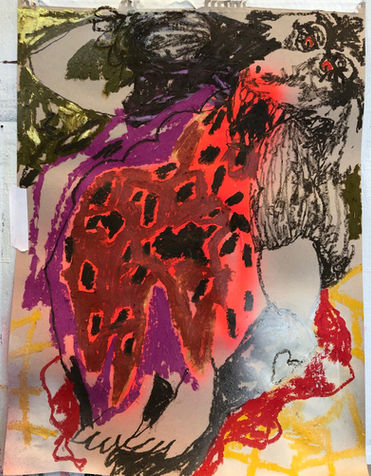
Dragon, Crab and Turtle TRAVELS to Italy
An Online Exhibition
June 14, 2021 to August 20, 2021
Dragon, Crab, and Turtle is pleased to present a summer exhibit at the Villa Ranuzzi Cospi located in the middle of sunflower fields outside Bologna. Built in the 1500s and then completely restructured before 1711, much of the extravagant baroque structure has been decorated with fantasy scenes from Roman Antiquity as well as pastel-coloured paintings of sea shells, exotic flowers and fanciful bucolic designs associated with summertime living. The owner of the villa, Prospero Ferdinando Benedetto Lorenzo Francesco Baldassare Ranuzzi Cospi, soon began to host the “Accademia dei Notturni,” an artistic and literary salon that met in his villa in the evenings to party—and his plan for the villa as a place fit for summertime entertainment, recreation, pleasure, culture and the arts has been successfully carried out ever since.
Portions of the interior space also feature 21st c. spray-painted murals by Katherine Bernhardt whose paintings focus on vibrantly coloured birds, pop culture icons, fruits and flowers, serving as backdrop and juxtaposition for a wide variety of other contemporary works by American artists associated with Dragon, Crab and Turtle including: Ashley Colangelo, Vaughn Davis Jr., Bianca Fields, Rachel B. Hayes and Jose Luis Vargas. All of this contemporary American art contrasts strikingly with the early modern Italian villa context, putting both places and eras into much greater perspective.
This summer show features primarily textiles: comfy quilts by Colangelo, heavily altered canvases by Davis Jr, fantastical animal-inspired drawings by Fields, bold and enormous floating banners by Hayes, and other-worldly canvases paintings by Vargas. The exhibit brings together unique top-rate work coming out of lesser known parts of the U.S.—including Missouri, Oklahoma and Puerto Rico—in order to share it with an Italian and global audience.
Curated on location by Elizabeth Bernhardt.

Katherine Bernhardt (St. Louis, MO) lived and worked in NYC for over two decades before returning to St. Louis where she founded Dragon, Crab and Turtle in the city’s mid-town design district. She is an internationally known painter who enjoys working with colourful pop-culture icons as well as themes from nature. Her Italian murals (spray painted on plastered walls during the summer of 2018) within a portion of the Villa Ranuzzi Cospi have never before been featured in a show or seen by the public.
Katherine Bernhardt, Installation views, Bagnarola di Budrio; Bologna, Italia, Untitled, Spraypaint , 2018
Ashley Colangelo (St. Louis, MO) earned her BFA from the School of the Art Institute of Chicago (SAIC). For this show she has blown up and distorted traditional patchwork patterns in order to create distinctively contemporary geometrical designs—all while exploring intense color relationships among patches inspired by nuanced schemes prevalent in Bagnarola and Bologna. She will be having her first solo quilt and bed show at Dragon, Crab and Turtle in September 2021.
Ashley Colangelo, Installation views, Bagnarola di Budrio; Bologna, Italia, 2021
Vaughn Davis Jr. (St. Louis, MO) earned his BFA in sculpture from Webster University in St. Louis. He enjoys the act of deconstruction by ripping, tearing, smushing and distorting his canvases in order to open them up, release flatness and free them. His work in this show reflects the color of intense yellow sunflowers that are just about to bloom outside the villa. He had a solo show at Dragon, Crab and Turtle in March 2021 and has been featured in mattoni rossi, an Italian publication dedicated to culture and the arts.
Vaughn Davis Jr., Installation views, Bagnarola di Budrio; Bologna, Italia, 2021
Bianca Fields (Kansas City, MO) earned her BFA from the Cleveland Institute of Fine Arts. She enjoys exploring and exaggerating animal faces and cartoon characters, and her work often stems from capturing original details from the eyes, whiskers, fangs and hands of select creatures. She had a solo show that included paintings, drawings and soft sculpture at Dragon, Crab and Turtle in April 2021.
Bianca Fields, Installation views, Bagnarola di Budrio; Bologna, Italia, 2021
Rachel B. Hayes (Tulsa, OK) earned her BFA in Fiber from the Kansas City Art Institute and her MFA in Painting from Virginia Commonwealth University. She is known for her lightweight and large-scale multi-coloured textile compositions that thoroughly transform their surroundings, indoors or outdoors. She has shown her work across the American West and around the world and has worked with Missoni.
Rachel B. Hayes, Installation views, Bagnarola di Budrio; Bologna, Italia, 2021
José Luis Vargas (San Juan, Puerto Rico) attended the Royal College of Art in London for his MFA and now runs an art residency program from Santurce, Puerto Rico. Vargas is fascinated with nature, the power of the supernatural and science fiction—as well as developing an understanding of himself and his art as a manifestation of the magic of our universe. We look forward to featuring his work in a solo show at Dragon, Crab and Turtle in October 2021.
José Luis Vargas, Installation views, Bagnarola di Budrio; Bologna, Italia, 2021
More on the Location:
For at least 5000 years we know that people have lived in the area, seemingly always rich with flora, fauna and various natural resources and benefits. Villanovians and Etruscans chose to live here for centuries before the ancient Romans founded Bononia (later “Bologna”) meaning “good,” “wealth” or “advantage” — back in 196 BCE. About one millennium later, from around 1088 CE and into our times, the famous University of Bologna has attracted thousands of students and with them a continuous flux of exciting new ideas.
Bagnarola in particular was chosen as the site for some of the most discriminating bolognesi of all times. Wealthy aristocratic families hunted in the area, hosted trade fairs there and built enormous summer villas (from the 1400s to 1700s) including L’Aurelia, Il Floriano, the Castello dei Bentivoglio and the Villa Ranuzzi Cospi—all massive neighbouring properties—and all properties thoroughly decorated as total installations of their eras, serving families who wished to escape the heat as well as enjoy freedoms from the social restrictions of more structured city living.
The Villa Ranuzzi Cospi is an extravagantly designed and perfectly symmetrical palace composed of five structures: the main central villa with multiple enormous reception and dining halls; two once-identical barchesse structures formerly serving simultaneously as carriage houses, stables for horses, and upstairs apartments where hundreds of servants once lived; a private chapel; and an ice house (whose facade imitates that of the chapel, disguising itself as a second chapel). Today approximately thirty families live in individual apartments that have been created throughout the five structures of the villa. And from 1986 until last year the villa hosted an incredible restaurant run by Giovanni Tamburini called L’Accademia dei Notturni.
Pheasants and hares thrive around the grounds of Bagnarola, and today a bird sanctuary in is home to ducks, geese, peacocks, nightingales, woodpeckers, magpies, parrots and many others. The area is also home to a wide variety of small animals such as frogs, toads, owls, moths, lizards, hedgehogs, bats, cicadas, praying mantises, fireflies, bees, lady bugs, spiders, scorpions and, last but not least, loads of mosquitoes. Overall, Dragon, Crab and Turtle are enjoying their summertime in the countryside among so many other Italian animal species.
Sunflowers (girasole), maize (granturco) and soy beans (soia) are commonly grown on this fertile plain. By the end of August, the 6-foot tall scorched sunflowers stand in place until they are thoroughly dried out and harvested for their seeds and oil. As night falls and plays tricks with our vision while enhancing our imagination, the huge flowers and their enormous faces and leaves resemble tall heavy-set women in old-fashioned costumes standing together in organized rows.
At the same time an intense relationship with the night sky develops: thousands of sparkling stars appear, shooting stars can be spotted, and visitors feel connected to the cosmos, to the myriad of constellations and their ancient stories that we don’t get to enjoy in cities; and this summer in particular we can feel more closely linked to magical otherworldly experiences thanks to the paintings of José Luis Vargas.
Back inside the villa, where the walls have been built of bricks several feet thick, the temperatures remain chilly. It is comfortable to sleep in such coolness thanks to the warmth from quilts stitched by Ashley Colangelo. The quilts are sleep-inducing only in darkness though—otherwise they make us ponder similar pastel colour schemes repeated throughout the villas as well as the red/orange/yellow combinations that have been popular on Bolognese homes for as long as we know.
The church dedicated to saints Giacomo and Biagio (built in the 1400s, rebuilt in the 1700s) continues to serve the community. The artistic highlight of this fancy country parish is La Madonna della Cintura, painted by a prolific early modern Bolognese artist, Elisabetta Sirani (1638-1665). Sirani was one of the first and few early modern European females who had the opportunity to learn how to paint—and in her brief life she make over 200 works. She founded a painting school for girls that helped open up this traditionally male profession. Painting became a possibility for more women thanks to Sirani and some other local artists: Prosperzia de’ Rossi, Santa Caterian de’ Vigri and Lavinia Fontana—collectively known as the “Bolognese phenomenon.” Female painters in the West have a connection to these early Italian artists who paved the way for change, including painters in America such as Katherine Bernhardt and Bianca Fields who continue to broaden our horizons for female painters—or for painters of any gender.
Although Sirani and others helped stretch the limits of gendered painting practices for centuries to come, Vaughn Davis Jr., has picked up the Italian tradition of working with canvas, first used by painters in Cinquecento Venice where ship sails served as a practical, lightweight, moveable and un-warping medium in an extremely humid lagoon city. However instead of painting with a set framed rectangular square in mind, like so many did for centuries, Davis Jr. takes the canvas one giant leap further by stretching, tearing, liberating and “freeing” it. Textiles used in innovative ways have long been a tradition at the Villa Ranuzzi Cospi since some of the ceiling decorations that look like frescoes are actually something completely different: the fresco-ish decorations were actually made on canvas, which was then cut and glued onto the ceiling, disguising itself as fresco painting. Painted elsewhere and with the help of gravity, Bolognese ceiling decoration specialists did not have to build near-impossible scaffolding and paint with paints dripping in their faces—like Michelangelo and many other ceiling painters.
The capacious volumes inside the country villa reflect the even more enormous spaces of the family’s urban residence, the Palazzo Ranuzzi Cospi, that serves citizens today as Bologna’s Tribunale (Court House). The colourful banners of Rachel B. Hayes could thoroughly transform any of these rooms, bringing color and high contrast wherever they are placed, inside or outside, and in the city or the country.
Dragon, Crab and Turtle Travels to Italy has been curated on location by Elizabeth Bernhardt, Ph.D., who has lived between Rome and Bologna (and also within a portion of the Villa Ranuzzi Cospi) for over 25 years. In Rome she taught many Italian history and art history courses and published two books that explain early modern Italian art in its natural context.


























































































